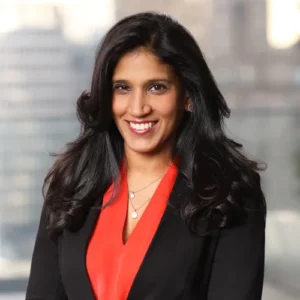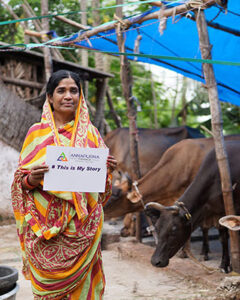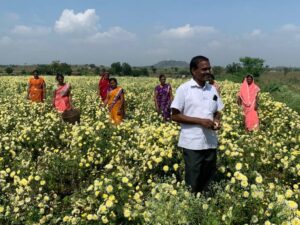Discover
Nuveen's private equity impact investing
Inspire
'We really like when we're serving low-income, underserved clients'
Invest
Impact and financial returns are not mutually exclusive
The Sustainable Finance Podcast is a weekly program featuring conversations with sustainability thought leaders such as cleantech entrepreneurs, VC investors, CEOs, NGO executives, and creators of the ESG indices and analytics platforms.
Episode 252: Targeting leaders for growth in low-income consumer markets
Radhika Shroff is managing director, impact investing/private equity at Nuveen, one of the world’s largest institutional investors. For Radhika and her Nuveen private equity team, their investment thesis is rooted in addressing two critical and inextricably linked problems: inequality and climate change.
With impact investing at an inflection point in 2024, I asked Radhika to explain how tackling these two issues creates attractive impact investment opportunities outside of traditional developed markets while offering investors stable, competitive returns — a process that also identifies companies best positioned to grow and lead in the decades to come.
Paul Ellis: Radhika, in the current market, what are some of the key trends in impact investing that you and your team are paying attention to in 2024?
Radhika Shroff: I have some key trends in mind, and as I thought about them, I hope they are not wishful thinking but are actual trends. We are focused on investing in growth stage businesses that are either solving a climate issue or an inequality issue.
The reason we’re focused on those two sectors is because we do believe that they’re inextricably linked, and that as the world warms, different populations are going to be impacted in different ways. So, for example, me living in an apartment building in New York City, I’m going be impacted very differently from climate change than a small holder farmer living on the coast of India. I’m also going be impacted very differently than somebody living in affordable housing also in New York City.
So we’re really focused on that confluence and saying it’s not just that we need to think about how to get more carbon dioxide out of the air. We do need to do that, but we also need to focus on ensuring that populations, wherever they are in the world, are resilient to climate change. And we believe that inequality plays a big factor in that.
The first broad macro trend that we’re seeing is that asset allocators are starting to see impact private equity as a mainstream asset class. And importantly, I think they’re also starting to see that you can invest with an impact fund and still expect the same returns that you expect from all of your mainstream private equity funds.
And not only can you expect them, you should expect them. The thesis behind this is that we’re not going to solve the world’s biggest problems without being able to attract commercial capital. And the only way we can attract commercial capital is by showing commercial capital that we can return private equity returns with our impact investments. And that impact and financial return are not mutually exclusive. They can actually go hand to hand.
We’re seeing through our efforts, our fundraising efforts, etc., and increasing recognition, that a fund like ours should be put on the same level as any other private-equity fund out there that might be looked at in terms of returns.
PE: I think those are very important points to make right up front because as you say, a lot of investors over the last 50 years or so have shied away from the private markets in terms of impact investing for a number of reasons. But what unique benefits can impact investing offer from both a financial and environmental and social impact perspective?

RS: Private equity is really the tip of the spear when it comes to driving impact in companies. So, as we know, private equity is longer term than public markets, and we have a five to seven year investment horizon. And so we’re able to sit at the table for at least five years working hand in hand with the company, the management team, the other shareholders, and we’re typically minority shareholders, to say not only how can we drive financial performance, but how can we also drive impact?
One example: We recently invested in a company called Power Takeoff, a company that drives energy efficiency in the small business sector, and its clients are utilities. The small business sector of the United States is typically underserved when it comes to energy efficiency solutions. And so we were super interested in that piece of it. As I’ve noted, we not only like to provide our capital, we like to provide engagement as well to help companies meet their goals.
With Power Takeoff what we’re doing is we’re leveraging the know how of our broader real estate platform, in particular, our affordable housing platform, which is the largest in the United States, and saying: How can we help this company increase its revenue, not only by targeting just small businesses, but also by targeting small business energy efficiency in low-income communities?
Right there you see an example of private equity being particularly impactful when it comes to driving both revenue as well as impact. And you also see coming to fruition our thesis that we want to make sure that low-income communities are not left out of the climate transition.
PE: So this is an example of a dual purpose focused on a particular investment idea and a company that offers these kinds of services. And you can apply it, as you’re saying, across a broad population of opportunity because of your engagement with the sector of the economy that it’s based in.
RS: Yes. What we’re saying is as private equity investors we can be patient, right? We do need to exit, but we can be more patient. And we can engage in such a way that drives impact. And if the impact is linked to the core revenue model of the business, as we drive more impact, we’re also driving more revenue. And that is really our goal as private equity investors.
PE: How do you and your team evaluate the investments that you’re in? There’s clearly a very-well-thought out process.
RS: I noted that we have a very well-thought-out impact thesis. We invest in either climate solutions or income inequality, and we love it when the two come together, when we invest in a business where we can help drive that equitable transition. But we’re like any other private equity fund. We look at the growth dynamics of the business.
We look at profit, profitability, we look at margins. We look at the segment, competition, we look at management teams. We look at the risk of the countries that we’re looking at. We look at competition and, importantly, we care deeply about exit optionality. We know being private equity and impact investors for over a decade that our industry needs to show investors that companies can be exited, and they can be exited in the same way, with the same velocity as a non-impact focused company. And so we’re really focused on exit.
I would say the way we look at our companies is the same way as anybody else, but we go a step further because we’re impact investors. We say, what is the “but for” of this company, if this company did not exist, what are the other options that the end consumer or the end segment has to solve this issue for themselves in a commercial way?
And this “but for” conversation is key and happens to be one of the most lively conversations we have on the team when we’re thinking about an investment because every single person on our team wants to be intellectually honest around the fact that this is a company, as it grows, it’s actually increasing its positive impact on the world more than not.

One example: We invested in an Indian microfinance institution called Annapurna Microfinance. Now, this is a company that served around 1.5 million female entrepreneurs with working capital loans so they could grow their business when we first considered investing. And we said, okay, “but for” our investment, what would actually happen here? Where else could these people go?
This is a company that happens to be going to some of the hardest to reach places serving women who are underserved from a working capital standpoint with well-priced loans. Since we’ve invested, this company has doubled in size and we are likely going to be able to exit in the next 12 to 18 months at really strong returns. And we’re saying, look, we invested, it’s doubled in size, and therefore it now serves 2.5 million women with working capital—not loans. And that’s where we see our investment going hand in hand with the impact that we’re trying to drive.
PE: That’s very impressive data. Can you give us the timeframe in which this has happened?
RS: We’re really proud of it. We invest globally, largely in the United States and India, and some of us on the team have been in investing in India for over a decade and driving the same level of returns that you would see in the United States on U.S. dollar terms. In Annapurna, we made the investment in March 2021. It was a really difficult time to be making investments in India. That was right before wave two of Covid.
But because we know the sector so well, and because we know the management team so well and the business model, we knew that if we made the investment at this moment in time, we would be strengthening the company’s balance sheet at a very, very good valuation. And we knew that those dollars would go towards making more loans to underserved communities. The company grew from 1.8 million clients to 2.5 million clients in the last three years.
PE: So is this part of your methodology that you and your team use in scrutinizing every type of investment that you’re looking at in these markets?
RS: Yes. We really like when we’re serving low-income, underserved clients, especially on the financial inclusion piece, which is largely in an emerging markets India play, but we also care deeply about climate. So again, for example, In India we invested in a company called Ecozen, a company that manufactures and markets IOT enabled solar irrigation pumps and cold storage, largely for small holder farmers who are living in areas that could be off the grid or have unreliable utility service. And this helps them keep their crops irrigated and store their crops for longer periods of time in order to increase their income.

And in that one investment, what we’ve done is invest in a climate mitigation, a carbon dioxide reducing product. In fact, that one company in one year alone, reduces carbon dioxide emissions by 500,000 tons a year. And we’re helping small holder farmers with the reliability of being able to grow and store their crops. So it is really emblematic of what we’re doing.
And by the way, all of these companies in our Fund One, they’re on average growing at 40% to 50% a year. What that really means to us is that we’re investing in commercially viable, profitable companies with strong profit margins that are serving an underserved segment of the community that really needs these basic services. And that’s really the sweet spot of what we’re doing.
PE: How do these underserved communities in these economies around the world react to a company like Nuveen coming into their community and offering this type of capital infusion and long-term investment strategy? That must be an extraordinary process and if you could just share with us some of the reactions that you get from the local people, that would be very helpful.
RS: Sure, absolutely. We have a really lovely video of clients in Annapurna talking about what Nuveen has done for their lives. But I’ll tell you, we’ve been investing in these emerging economies for over a decade. We’re pretty well known. When we come to the table and say we want to look at this business, people are excited and happy. Because they know a couple things.
One is that we are intellectually honest around caring about impact. And so that gives management comfort that we’re not going to be there just driving profitability for profitability’s sake. We want to make sure that profitability is coming in lockstep with the impact. And so it gives them some sense, OK, it’s this big U.S. firm, who are they going to be? What are they going to be like? They know from our reputation that we are going to be there to support them on the impact side as well.
The second thing, they know we can really help them scale. We typically come in, we’re not venture investors, but we’re also not TPG Rise. We are there to help them with what we call the missing middle: we believe there’s a lack of commercial investors in that stage of the company development from when it’s proven the commercial viability of its product or service to what is completely scaled to be able to exit to the public markets. Or to be able to do a strategic sale or sell to a TPG Rise for example.
And they know that we’ll be there, and we know how to help them scale. I think we see that our pipeline outside the United States is just as exciting as our pipeline inside the United States and that’s why we’re building a balanced portfolio.
PE: That’s terrific news. A lot of people in the private markets in developed economies look at the potential risks of these types of investments and shy away from them. What you’re saying is that you have dug much deeper into the process of these economies and the people that you’re working with and come up with ideas that are leveraging opportunities in those economies and at the same time de-risking the longer term investment strategy. Am I on the mark?
RS: Absolutely. And it takes a great deal of experience to be able to do that. Like it’s pattern recognition. It’s the people you know understanding, you know you can’t predict, but you can understand how currencies move, the macro environment, we’ve done all that. We’ve been doing it for over a decade.
And as I said, and I can’t say this enough, the things that we see in India, in particular the growth that we’re able to see there, the returns we’re able to drive are on par, if not better, than some of the developed economies we look at.
PE: Are there other developing economies around the world that Nuveen is looking at or already engaged with that you can share with us?
RS: We look at all of the largest economies. So, some of the larger countries in Southeast Asia and Latin America. We actually have an investment in a payments company in Latin America that essentially provides mom and pop shops in rural areas in Peru with a handheld device so they can turn into mini bank branches.
So this is really financial inclusion. You are going into the Andes Mountains. You’re handing a store owner a handheld device and a customer that lives in that neighborhood doesn’t have to travel 3 hours to the nearest bank branch. They can do simple financial transactions at this mom and pop shop in their neighborhood.
And this mom and pop shop, which is owned often by a female entrepreneur, is able to increase the revenue of her shop by 20% to 30%. And these investments outside the United States are made after deep (review); I had known this company for 10 years before I made the investment.
Financial inclusion is something we know really well. So we don’t take it lightly. We know that investing outside the United States has its macro risks. But I think if you have the right team that has done it for a long time and knows how to underwrite for those risks to the extent possible, you can end up with really good, strong risk adjusted returns.
PE: Radhika, where can people go to learn more about private equity impact investing at Nuveen?
RS: You can find us on the new Nuveen website. We have some really interesting thought leadership pieces there, where we talk about why we invest in India, why we invest in companies that are focused on decarbonization of buildings. And anyone can find me on LinkedIn.
Read more: The Sustainable Finance Podcast: Engaging the C-suite in ESG